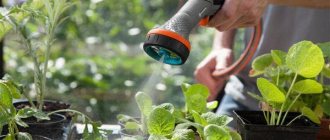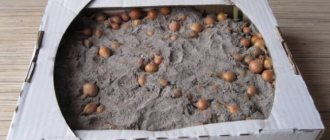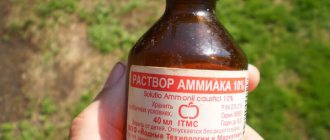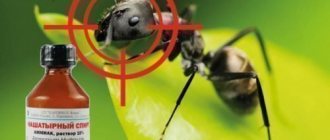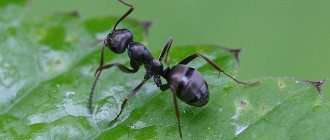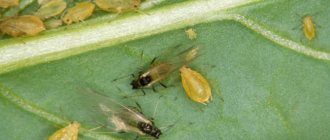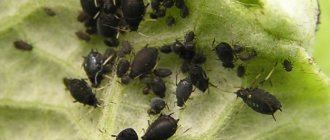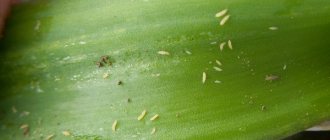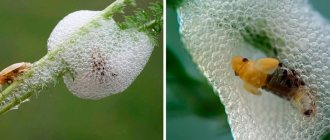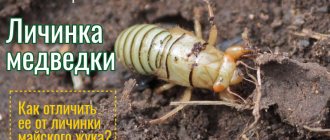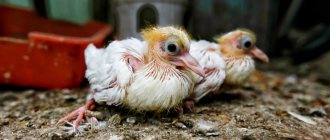Aphids are one of the main enemies of summer residents and gardeners.
These insects attack plants, feed on its juices, which leads to the death of the crop. Dealing with aphids can be quite difficult. Today we will tell you about an effective remedy in the fight against this insect, ammonia. Dear readers! For you, we have created communities on social networks in which useful articles and interesting ideas are published several times a day! Subscribe and receive useful content in a convenient format!
How does ammonia work on aphids?
Many cultivated plants suffer from aphids. The most delicious plants for the parasite are currants, viburnum buldenezh, roses, cherries, sweet cherries, apple trees, and cucumbers. But in general, these small parasites can be found on any cultivated plant.
Ammonia causes respiratory arrest and paralysis of the insect's respiratory system. In addition, it causes swelling and burns. As a result, the pest cannot breathe and dies from suffocation.
What trees and shrubs are affected by aphids?
In garden plots you can find several varieties of aphids. It can be green, black, red and even yellow. A small winged insect up to 4 mm in length. The pests are very prolific. If you do not fight aphids, then you may not recognize your garden and garden - insects will literally eat everything.
Most often, aphids settle on young leaves and shoots of currants, roses, and viburnum. At the same time, black and red currant bushes can be attacked by different types of aphids. Pests love apple and cherry trees. Cucumbers and zucchini also do not go unnoticed by winged pests. Aphids can settle on gooseberries and raspberries.
Among flowers, roses get the most. Aphids on roses destroy the tops of branches and young shoots. Rose buds wither without blooming if a colony of aphids lives on the buds for a long time. The photo shows two types of pests at once.
Green and red aphids on roses
Petunia also loves insects. If a colony of aphids settles on petunias, the flowers become sticky and lose their decorative effect.
If chemical insecticides can be used for flowers, then for fruit plants it is better to use natural control methods. Where there is this evil spirits there will be ants. This couple lives in peace and harmony to harm the gardeners. When choosing methods to control aphids, do not forget about ants.
How to make a solution of ammonia, effective recipes for aphids
It is very simple to prepare the working solution. Prepare a ten-liter bucket of settled water.
IMPORTANT! Do not use water directly from a well or pipeline for spraying.
Carefully pour a bottle of ammonia (50 ml) into the bucket. Stir and use immediately. To prevent the solution from eroding, you can dilute the drug directly in a sprayer, then reduce the dose several times. For 1 liter of water you need 2 tablespoons of the drug.
To make the product stick better and stay on the leaves longer, add soap to the mixture. Laundry soap is the most effective. It is grated so that it dissolves faster.
To enhance the effect of the drug, you can add strong-smelling ingredients to it. For example, garlic infusion. First, grate or finely chop the head of garlic. Fill the mixture with water and leave to infuse for a week and a half. Then strain the mixture and add the liquid to a bucket of water and ammonia.
ON A NOTE. When treating with ammonia, it is better not to use fine spraying. In this case, the ammonia will quickly disappear. Set the sprayer to medium spray level.
How to use
When removing aphids and ants from an area, ammonia is good because it does not accumulate in the soil and fruits. Therefore, this product can be used throughout the growing season: from the initial germination of crops to the period of fruit ripening, as well as after harvesting. Be sure to add soap or shampoo to solutions with ammonia to increase the effectiveness of the drugs and give them sticky properties.
To properly spray bushes and trees with solutions containing ammonia, you will need the following materials and equipment:
- Spray. Its volume depends on the number of green spaces requiring treatment. It is also worth paying attention to how to treat currants with ammonia in the same way.
Using a plant spray - Gauze bandage . This remedy will protect your respiratory tract from getting caustic ammonia into it.
- Gloves.
- A bucket to dilute the solution with the required concentration.
- Actually, ammonia itself . We recommend purchasing it in garden stores - the volume of bottles there is much larger, so the cost of processing will be more economical.
- Soap . Take either household or tar, since these types have the highest antibacterial and disinfectant characteristics. You can use laundry soap against aphids on roses.
- Water.
Using the simple materials listed above, you can properly treat your garden with ammonia from aphids and ants.
For which plants can ammonia be used?
Almost all plants can be treated with ammonia. Let's talk about some of the nuances of spraying.
Treat only buds, shoots and leaves. Do not work with flowering plants. Roses are best sprayed with a hand sprayer.
When processing currants and apricots, unroll the curled leaves. Aphids hide in them.
It is also better to spray Buldenezh manually. Here aphids accumulate near the rosettes of leaves and near the petioles.
Pay special attention to spraying cherries. The tree forms a dense crown, and aphids most often hide on the back side of the leaf blade. Therefore, cherries need to be treated at the first sign of aphids. Otherwise, it will be very difficult to deal with it later.
Other crops are processed by simple spraying: tomatoes, peppers, dill, raspberries, cucumbers, etc.
ON A NOTE. Treatments with ammonia can be carried out once every 20 days.
Fighting methods
You can quickly and safely remove aphids from plants mechanically. To do this, you simply need to crush the insects or wash them off the plant with a stream of water. On the ground, aphids quickly die, becoming easy prey for other insects - predators.
This procedure is very effective for small colonies of aphids, but in case of mass lesions (or a large planting area) they turn out to be very labor-intensive and ineffective. In this case, folk recipes will come to the rescue, the use of which can be used to treat and prevent damage to plants by aphids. It will also be useful to learn about how to spray roses against green aphids.
Herbal decoctions
It is very easy to prepare such decoctions, and a wide variety of cultures are suitable for this. The algorithm of actions is very simple. First, the main ingredient must be boiled in a small amount of water.
Herbal decoctions
The mixture should brew for a couple of hours, after which it is filtered and diluted in large proportions. Usually take a liter of concentrated solution per 10 liters of water. Spraying must be done on the same day, because the composition loses its properties during storage. To prepare the solution, you can take one of the ingredients listed below.
You may also be interested in information about what powdery mildew on violets looks like in the photo, and how you can fight it.
What decoctions will help against aphids:
- Chopped tomato leaves (about 400 grams per serving).
- Garlic arrows (200 - 300 grams).
- Garlic cloves (50 grams).
- Potato tops (0.5 kilograms).
- Tobacco leaves (400 grams).
- Fresh parts of celandine (300 – 400 grams).
- Onion peel (1 kilogram).
- Chopped wormwood (300 grams).
It will also be useful to learn about how to deal with moss in your summer cottage, and what products should be used first.
To enhance the effect, you can add regular laundry soap or a special insecticidal soap to the decoction. The soft shells of aphids quickly soften when exposed to detergents. In addition, this component improves adhesion to leaves and other parts of the plant. Thus, the product is not washed off even in light rain. Instead of soap, many gardeners use dishwashing detergent and liquid soap. It depends on individual preferences, as well as capabilities, so what exactly to add is up to you.
Soap and ash solution
Among the simplest and most affordable are treatment with soap solution or wood ash.
Preparing such solutions is as easy as shelling pears: for 10 liters of water you need to crumble 50 grams of laundry soap and 300 grams of ash. This treatment is carried out every week and, when used, provides not only reliable protection, but also additional nutrition for the plants.
Vinegar treatment
Diluted vinegar essence can also kill aphids. To do this, you need to take about 30 tablespoons of vinegar (70%) in a bucket of water and also add 5 tablespoons of dishwashing liquid. Carry out the treatment three to four times per season until the pests are completely destroyed.
Alcohol sprays
A simple and effective way. To do this, ordinary vodka or alcohol diluted with water is used as an insecticide. The method is good for its simplicity, but for some flowers it will be a serious test, so before treating the entire area, it is recommended to test the effectiveness on an individual plant.
It may also be useful for you to learn about how ornamental cabbage is planted with seeds and what chemicals will help in pest control.
On the video - what to spray against aphids:
Iodine and soda against aphids
The original recipe against pests. Take two tablespoons and 40 drops of regular pharmaceutical iodine into a bucket of water. Spray the plants immediately after preparing the solution.
This treatment is very effective and safe for soil and plants. Instead of soda, you can add 100 ml of fat milk - the effect will be the same.
Treatment with ammonia
Ammonia purchased at the pharmacy is also an excellent remedy against aphids. To do this, use two tablespoons of ammonia and liquid soap per bucket of water.
Soda against aphids
To combat aphids, you can use regular lemonade or the well-known Coca-Cola. To do this, simply insert the sprayer into the bottle and spray the roses.
Pros and cons of using this product
Let's say a few words about the pros and cons of using this tool.
The benefits of ammonia include:
- Efficiency in the fight against aphids;
- Cheapness and availability;
- Ease of preparation of the working solution;
- The product acts immediately;
- Ammonia is a source of nitrogen, that is, at the same time it is a foliar nitrogen fertilizer.
The disadvantage of this product is:
- Ammonia volatility;
- Inability to work with the drug for a long time (may cause respiratory arrest).
- Difficult to use on large trees;
- May cause an excess of nitrogen in plant tissues.
Description and action
Ammonia is familiar to many - it is a colorless liquid with a specific, difficult-to-tolerate heavy odor. Note that this substance is also used in cosmetology, in the manufacture of household chemicals, and even in food production.
Ammonia, or ammonia as it is also called, is a quite effective remedy against aphids. This medical substance for its original purpose has found considerable application in the economy, including agriculture. The damaging effect of ammonia on aphids and ants goes in two directions: firstly, the substance, having a pungent odor, repels pests from the area. And secondly, it destroys those insects that are directly affected by drops of the solution. But this information will help you understand how to fertilize melons and watermelons with ammonia and what results can be achieved.
The principle of action of ammonia on a pest is as follows: the substance enters the digestive tract of the insect, which causes a burn to the walls of this tract, leading to swelling, paralysis and subsequent death of the aphid or ant. In half of the fatal cases, the substance simply does not have time to reach the digestive tract, since the strong aroma of the product paralyzes the pest’s breathing, and the latter dies.
Ammonia also acts as an irritant on ants. Smelling a strong unpleasant aroma, the ants leave the area in a hurry. In addition to aphids and ants, ammonia is also effective against mole crickets, onion and carrot flies, and wireworms.
Ammonia can quite effectively cope with aphids at the beginning of the formation of their colony. However, if the colony is already large, it is necessary to use more potent chemicals to save the harvest. Please note that if “military action” aimed at defeating aphids is not started in time, the pest will be able to destroy not only the entire crop, but also cause the plants themselves, even mature trees, to die.
It is also worth learning more about whether you can water onions with ammonia, and how to do it correctly.
Note that ammonia is good because it destroys not only the insects themselves, but also their larvae and eggs. Thus, the elimination of the pest occurs at all stages of its development, which is very important.
The substance, unlike many herbicides, is safe for the environment, does not cause damage to cultivated plants, does not harm water bodies, beneficial insects, birds, and does not accumulate like nitrate in fruits.
But how strawberries are treated with ammonia in the spring, and what you should pay attention to, will help you understand the information at the link.
In the video - ammonia against aphids:
In addition to all the listed benefits, ammonia is quite accessible and very inexpensive. It can be easily purchased at a pharmacy, and if you need a large volume, then in garden stores. In addition to its damaging effect on pests, ammonia is also a plant food, as it contains nitrogen in large quantities. It will also be useful to learn about how to fertilize tomatoes with ammonia.
Precautions for use
When working with ammonia, you need to be careful. Protect your eyes and respiratory system. Remember that ammonia vapor can cause temporary respiratory arrest. Therefore, be sure to dilute the liquid outdoors. If you have to work indoors, open the windows.
Carry out spraying in calm weather. It is best to do this in the morning or evening after sunset.
Another important point: do not use the product during flowering, as ammonia vapor is harmful to beneficial insects too.
Rules of application
So, the main and basic rule of use is that it is forbidden to use it in its pure form, since in undiluted form the product will cause burns on plants. Before processing, a working solution should be prepared. Remember that the substance in its pure form is also dangerous for humans, as it can cause serious damage to the skin and mucous membranes.
It is not recommended to prepare the working solution in large quantities and in advance for carrying out several treatments. The fact is that volatile substances are most effective in a freshly prepared solution; over time they erode and the solution becomes ineffective.
Often, when processing, a watering can with a wide nozzle is used. This makes it possible to treat all the leaves of the bush, the lower shoots, which often have the largest concentration of aphids. The watering can can be replaced with a spray bottle, which will be as convenient as possible when treating plants at home.
Does ammonia help against aphids?
The experience of various summer residents shows that ammonia copes with aphids. But there is one caveat. Processing should be targeted and targeted. That is, you need to spray the aphids directly. This is easy to do on small shrubs or young trees. You can process both the upper and lower parts of the sheet plate. But with a large bush or tree it will be more difficult. Some insects will survive and breed again. Therefore, when large plants are seriously infested, it is better to use more powerful insecticides.
What happens if proper measures are not taken?
If you do not take any action - special techniques developed over a long time, including folk recipes - then during the summer the aphid can produce up to fifty generations inclusive.
In this situation, any area, even an unusually well-groomed one, will be significantly damaged. The number of pest species in the Northern Hemisphere alone exceeds four and a half hundred and is among the most dangerous pests of agriculture, horticulture and forestry.
Solving the question of how to deal with aphids is sometimes extremely difficult: the fact is that their reproduction rate is extremely high. By trying to get rid of it as quickly as possible, the owners of the site will be able to save their harvest.
Errors during use
Despite the ease of preparation and use of the product, some gardeners make mistakes:
- The working solution is not used immediately. In general, for the treatment to be as effective as possible, the working solution must be prepared directly in the garden or vegetable garden. Ammonia evaporates very quickly.
- Failure to comply with dosage. The drug is not only an insecticidal agent, but also saturates plants with nitrogen. Take this into account when treating them against aphids. During flowering and fruiting, excess nitrogen harms the plantings.
- Processing is carried out without personal protective equipment. Ammonia vapors can cause burns to the nasal mucosa and even cause loss of consciousness. Therefore, firstly, use personal protective equipment, and secondly, do not work for too long.
Folk remedies
Fighting methods can be divided into methods:
- Physical effects aimed at reducing the population, removing places where insects live comfortably, or destroying the queen.
- Using insect repellents.
An effective remedy for ants in a greenhouse is potatoes, since the gastrointestinal tract of insects is not able to digest starch. To destroy the population, it is enough to chop up potato peelings and spread them in the immediate vicinity of the anthill. Millet cereal causes a similar effect. Insects die when consuming raw millet.
The simplest and most effective way to physically kill insects is to treat the anthill with boiling water. You can use jam, honey or sugar syrup as bait for insects. A jar with such contents, left for several days near an anthill, will be filled with insects. To destroy them, you just need to fill the container with boiling water.
The most popular folk remedy for ants in a greenhouse is garlic, which needs to be chopped and mixed with sawdust. The resulting mixture should be sprinkled on the ant heap. An aqueous solution of garlic also works very well: 1 chopped head per 10 liters of water. Another good way to fight ants is to spray their habitats with a kerosene solution: you only need 2 tablespoons of this product per bucket of water. You need to water the anthill and places where insects accumulate with solutions.
The smell of mustard is known to effectively repel insects. It is simple to use: dry powder is sprinkled on paths, row spacing and all wooden elements of the greenhouse structure. This method is inexpensive and effective, but only with a small population of ants in the greenhouse.
What plants repel ants?
Planting plants whose smell is poorly tolerated by insects is popular among domestic greenhouse owners. Practice has shown that insects never build their homes near mint and wormwood plantings. If you have a question: how to get rid of ants with wings in a greenhouse without resorting to treating the plantings with chemicals.
The easiest option is to plant insect repellent plants near garden crops:
Planting these plants in the greenhouse will protect cultivated plants from ants. According to experienced gardeners, to remove ants from a greenhouse, it is enough to simply spread these plants in places where insects accumulate.
How to treat the soil against ants in a greenhouse
Soil treatment methods:
- Pre-planting soil preparation involves treating with an aqueous solution of soda and linseed oil. To create a solution you will need: 1 liter of water, 5 g of soda and 30 ml of oil.
- To kill insects, the anthill and places where parasites accumulate are filled with boric acid.
- Ammonia is an excellent means of combating the ant population in closed ground conditions. For 5 liters of water you will need 2 tablespoons of ammonia. The solution must be thoroughly poured into the ant heap.
How to poison ants in a greenhouse
Among the many folk remedies for controlling insects in greenhouses, boric acid is highly effective.
Boric acid is a specific chemical preparation, large doses of which, if ingested by animals and humans, can lead to serious poisoning
Take precautions when using boric acid
Effective poison baits can be made using boric acid. We offer one of the most popular recipes, which is very easy to prepare:
- Dilute ¼ tablespoon of boric acid in 1 glass of water.
- Add 4 tablespoons of sugar, jam or honey to the solution.
The contents should be divided into small containers and placed throughout the greenhouse. The second option for poisoned bait to fight ants is meat balls with the addition of boric acid, which need to be laid out in the greenhouse. The recipe is simple: add 1 teaspoon of boric acid to 100 g of minced meat.
As practice has shown, the best way to prevent the appearance of ants in greenhouses is to annually dig up the soil in the greenhouse in order to damage the anthill, destroy the larvae and egg-laying sites, and then add wood ash, lime and baking soda to the soil.
Answers to frequently asked questions
What ammonia should I use?
An ordinary bottle from a pharmacy will do.
Is it possible to treat indoor flowers with the drug?
Yes, but be careful not to get poisoned.
How many treatments are needed?
Usually 1-2 is enough. But it all depends on the degree of infection of your plants.
How to enhance the effect of the product?
Add garlic infusion or ground pepper.
Recipe with ammonia for garlic
Ammonia is also useful for garlic. Only now it is not sprayed, but watered. A solution of ammonia acts here as a nitrogen supplement in the spring when feather tips turn yellow, as well as for protection against onion flies.
The solution is prepared by analogy with the first recipe:
- 2-3 tablespoons of 10% ammonia are poured into a 10-liter bucket of water, mixed thoroughly and watered from a watering can or ladle.
For feeding, one treatment is enough; to combat onion flies, watering is carried out three times (with an interval of 10 days).
How to fight aphids at your dacha in open ground
The damage that aphids cause to vegetables and fruits is enormous. Insects can lead to complete destruction of the crop and the plant as a whole. There are several types of aphids, so they are dangerous to almost all trees, shrubs and vegetables. The difficulty in destroying it is that it is very small and it is difficult to notice it at first, and insects reproduce very quickly.
in spring
In spring, aphids wake up on the first warm days. Start the first preventive measures while planting :
- First of all, sanitize trees and bushes, if you did not do this in the fall. Get rid of all affected plant parts. It is best to burn them or take them away from the site.
- First of all, insects attack young plants or new shoots. Examine them carefully. If you see clutches of aphid eggs, destroy them. Irrigation with hot water (temperature 80 degrees, no less) will help.
- Destroy all anthills on the site. Ants are carriers of pests; they deliver insects to bushes and trees. Aphids by themselves can only climb onto low plants. Water anthills and ant egg nests with boiling water.
- Sprinkle paths with wood shavings or mulch plants with sawdust. The buzzer loves to live in them. She eats aphids and acts as a natural orderly.
- Whiten the plants and remove old bark. Aphids hibernate under it.
- Collect young dandelions and prepare an infusion against aphids. Treat trees and shrubs with it.
- The plum tree is most susceptible to aphid attacks, especially its young shoots. In spring, be sure to remove all root shoots.
- Plant plants in your garden and beds that repel aphids with their scent.
In summer
If prevention does not help, in the summer they begin to destroy aphids. It's best if you notice it right away. Then it will be enough to remove the affected branches or wash off the insects with plenty of pressure several times.
If you missed the moment, folk methods will come to the rescue. Sprinkle the plants generously with mustard or wood ash. Prepare solutions based on herbal ingredients and soap, for example, from sorrel, onions, horseradish, hot pepper, pine branches.
Available means will come to the rescue, for example, iodine, vinegar, soda, Coca-Cola, ammonia, and laundry soap. It is easy and quick to prepare solutions for spraying the area from them.
